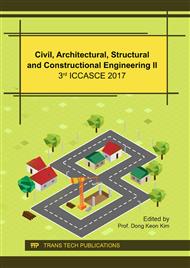p.23
p.28
p.35
p.41
p.49
p.54
p.61
p.70
p.76
Skew Reduction Factors for Moment in NEXT Beam Bridges with Integral Abutments
Abstract:
Northeast Extreme Tee (NEXT) beams have been recently developed for the accelerated bridge construction. The skew effect on live load distribution in a NEXT beam bridge, especially with integral abutments, is not clear and shall be assessed. In this paper, various skew NEXT beam bridges are evaluated through validated finite element (FE) analyses with solid brick elements. Parameters as studied include beam section, span length, and skew angle. Per AASHTO LRFD specifications, one- and two-lane loaded cases are examined to obtain the maximum tensile strains in beam stems under the design live loading (HL-93). Unskewed bridges are used as control specimens to compute skew reduction factors (SRF) for moment from the obtained FE strains. The FE- and LRFD-SRFs for moment are compared in terms of figures, which indicate the LRFD-SRFs have good agreements with the FE-SRFs at large. For the majority of the bridges, LRFD-SFRs govern the FE-SRFs. The research findings from this paper are useful for practicing engineers to safely design a skew NEXT beam bridge with integral abutments.
Info:
Periodical:
Pages:
49-53
Citation:
Online since:
February 2018
Authors:
Keywords:
Price:
Сopyright:
© 2018 Trans Tech Publications Ltd. All Rights Reserved
Share:
Citation:


